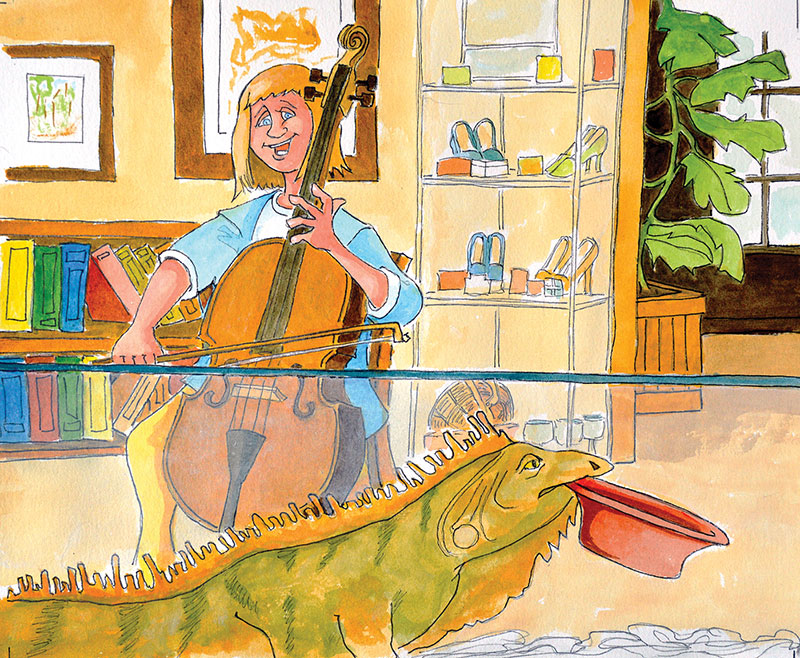Robert E. Wrigley
From over-grown fish to biting parrots, a surplus tiger to a black bear cub, unwanted pets and orphaned animals were something I had to deal with through all my three career positions. I was able to accept certain of these animals at my institutions, but often they were sent to other facilities in Canada or the United States. These kind of telephone calls were an unwelcome distraction from my regular duties because they often came with the proviso that the animal would be put down if I proved unsuccessful in placing them. Suddenly being responsible for an animal’s survival placed a heavy responsibility on me, and I had to drop whatever I was doing and start a barrage of phone calls to colleagues.

A big green iguana I will always remember, because it taught me an important lesson. Its history was the usual story of a person making a snap decision to purchase a small cute pet, only to find out later, as it grew, that they no longer wished to continue providing for its care. And so it was, I accepted an adult iguana – a native of the American tropics. This 1.2-mch-long reptile I thought would make an excellent interpretive animal, since I was able to handle it and to show it to school classes. Not having a suitable enclosure at the Museum at the time, I took the iguana home temporarily, housing it in a large terrarium in a sunny front-room window, where it became quite a conversational piece for visitors. Everyone wanted to know its name, so we came up with ‘Johanna the Iguana!’
Johanna displayed a remarkable range of behaviours far beyond what I thought capable for lizards. She kept a watchful eye on our two Persian Cats, which often approached to inspect this strange-looking green intruder, basking just beyond the glass wall. The cats soon became bolder and took to jumping on top of the terrarium for a closer look, while Johanna cocked her head and stared upward at them with one eye. On one occasion, I removed the two large panes of glass off the top of the terrarium to enable me access to clean up the soiled newspapers on the cage floor; I had to bend my entire upper body inside the structure to complete the task. Johanna watched my every move from the other end of her home. Suddenly all hell broke out. One of the cats, deciding to investigate what I was doing, jumped on top of the terrarium, but instead of landing on the glass lid, it descended right on top of Johanna. Both animals panicked, thrashed about violently, and hissed in the tight space. I had no idea what was happening and then received a sharp whip of the iguana’s tail across my hand. Instinctively I reached around and grabbed the cat by the scruff of the neck, and flipped it onto the nearby couch, while Johanna dashed back and forth. The explosive misadventure ended without any of us being injured, but there were three hearts beating thrice the normal speed for some time.
Although I offered a variety of vegetables and fruits to Johanna, her favourite meal was definitely green peas. She also liked spaghetti, and it took her some time to master the technique of gulping down the noodles, after which she sported orange-sauce lipstick on her mouth for the rest of the day. My wife Arlene Dahl (cellist in the Winnipeg Symphony Orchestra) taught students cello in the same room as Johanna’s home, and they would always greet our pet on arrival. Seeing action in the room, and impatient for her dinner, Johanna astonished my wife one day when she picked up her plastic bowl in her mouth and began knocking it repeatedly against the glass wall. The iguana was so persistent and noisy that the lesson came to a halt, and I was called downstairs to witness this amazing feat of problem-solving. Johanna had figured out how to manipulate a tool to ensure fast-food, home-delivery service. The three of us howled with laughter as Johanna continued to whack the bowl and then to pause to see if her actions were having the desired effect. I had to prepare her dinner of peas before the cello lesson could resume. I had no idea a reptile’s brain could master such a feat.
However, the lesson I referred to in this story’s title was Johanna’s stress-reducing technique, which I sometimes practice to this day. Whenever something upset her, she tipped her head upwards and simply closed her eyes. If she couldn’t see the cause of her distress, it simply didn’t exist! I thought this was such a fascinating way of avoiding certain stressful situations – if one cannot avoid or solve a stressful situation, pretend it doesn’t exist and get on with life. This technique does not work with every anxiety, but it sure beats prescription medication for some problems that may dissipate on their own in time.
• • •
This is an excerpt from Dr. Robert Wrigley’s new book entitled; “Chasing Nature: An Ecologist’s Lifetime of Adventures and Observations.” The 367-page book contains 230 short stories featuring 750 species of animals and plants, and is richly illustrated with 130 photos and illustrations. The anecdotes are refreshingly quirky and fun while teaching us something new about the animal kingdom. A copy signed by the author ($55) will make a great Christmas present. Enquiries: [email protected]

